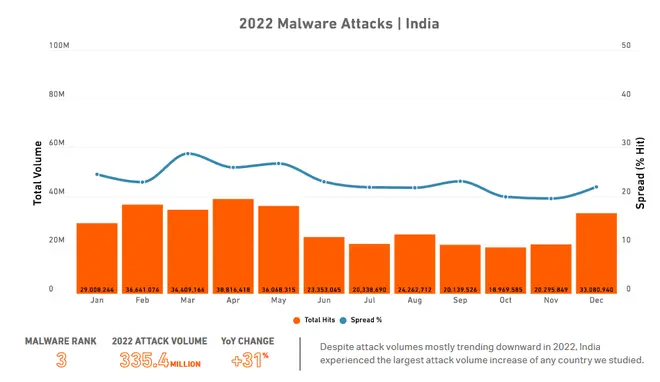Here’s a piece of good news for cybersecurity news watchers. Ransomware attacks globally saw a dip of 25 per cent last year. But the bad news is that the threat continues to lurk as the overall numbers are above the pre-pandemic figures, and hackers are finding newer ways to extort victims by stealing the info thru social engineering methods.
Cyber security experts recorded nearly half-a-billion ransomware attempts in 2022, giving sleepless nights to organisations.
“We aren’t actually seeing any sort of widespread abandonment of ransomware,” SonicWall has said.


In a global survey by SonicWall, over 91 per cent of the respondents said that ransomware remains their primary security concern.
Malware rose for the first time since 2018, reaching 5.5 billion attacks. While overall malware attacks witnessed a marginal growth of 2 per cent, the malware targeting IoT (Internet of Things) devices saw a growth of 87 per cent at 112 million attempts.
The sectors like education, finance and retail were among the worst hit by malware attacks.
SonicWall Capture Labs said that Russia-based hackers seem to have been hit by their country’s war with Ukraine.
Read also: Why hackers love backups
“With roughly two-thirds of state-sponsored cyberattacks coming from Russia, and 75 per cent of money generated by ransomware in 2021 going to groups highly likely to be affiliated with Russia, anything affecting that country has an outsized effect on cybercriminals,” it said.
Intrusion attempts
The year also saw a surge in intrusion attempts. At 6.3 trillion, intrusions grew 19 per cent over 2021. “This is roughly six times the number of overall attempts observed in 2013,” it pointed out.
Getting ready
“An increased awareness of ransomware motivated many organisations to create and maintain strong backups and incident response plans, making file encryption less effective than it once was,” the report said.
Interestingly, some groups have moved to extortion attacks, marked by no encryption of endpoints.
“By using social engineering, vulnerability exploits, stolen credentials or other tactics, these groups gain illegal access to a target network. Then, once they’ve stolen data, they threaten to leak the information if victims don’t pay up,” the report said.
“While these attacks involve reputational damage, data leaks, and the risk of compliance issues and lawsuits like traditional ransomware, they’re much harder to trace,” it pointed out.








Comments
Comments have to be in English, and in full sentences. They cannot be abusive or personal. Please abide by our community guidelines for posting your comments.
We have migrated to a new commenting platform. If you are already a registered user of TheHindu Businessline and logged in, you may continue to engage with our articles. If you do not have an account please register and login to post comments. Users can access their older comments by logging into their accounts on Vuukle.